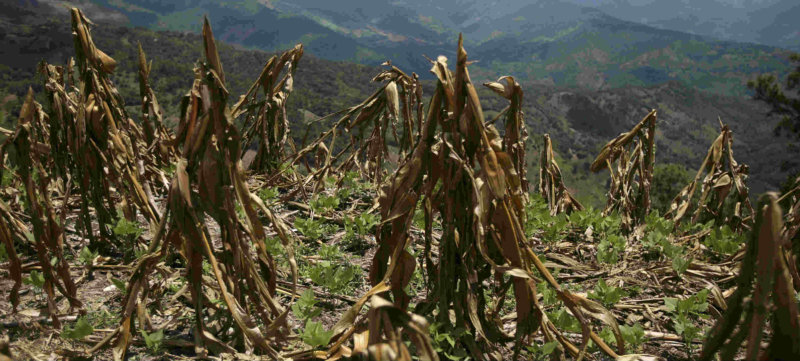HOUSTON — These past three years of drought in Central America have destroyed crops of corn and beans, leaving families starving and causing Guatemala to declare a true state of emergency, said Baltimore-based Catholic Relief Services officials.
These families are among the “poorest of the poor” who are helped by U.S. parishes participating in CRS’ Lenten Rice Bowl campaign, said Monica Rodriguez, project manager of CRS’ SEGAMIL, a program in Guatemala that trains women how to earn funds and provide nutritious food for their children. SEGAMIL is the Spanish acronym for Food Security Focused on the First Thousand Days.
The annual campaign run by CRS, the U.S. bishops’ overseas relief and development agency, raises awareness and funds to combat hunger and poverty. Schoolchildren, parishioners and families are encouraged to put savings from their Lenten fasting into a cardboard “rice bowl.”
Rodriguez recently visited several Houston parishes and schools. She thanked them for past participation and encouraged them to start a new Lenten project through the Rice Bowl campaign whether individually, classes or churchwide.
“This project really makes a difference. We are partners in change,” said Rodriguez, accompanied on her visits by CRS colleague Anna Huth and Hilda Ochoa, director of the Mission Office of the Archdiocese of Galveston-Houston.
She emphasized that 75 percent of all funds goes directly to cutting the cycle of poverty while each diocese retains the remaining 25 percent for its own food pantry and other programs to help the poor.
“This is the worse it’s ever been, many farmers are saying,” Rodriguez said of Central America. She described the rural villages where Mayan women are losing their crops, then their husbands who move on looking for work and then their children through malnutrition.
According to the U.N. World Food Program, nearly 50 percent of children under age 5 are considered chronically malnourished in Guatemala, a measure that peaks to 90 percent or higher in many rural areas.
“I also talked with parish social ministers at the Houston offices of Catholic Charities. Several of them had conducted Rice Bowl projects here and were glad to see how the funds directly help many of these families,” Rodriguez said.
Johana Ferro, director of religious education at St. Jerome Catholic Church, said her faith formation classes have been able to raise thousands of dollars over the past 10 years for the Lenten Rice Bowl project.
“We order the free materials through the crsricebowl.org website that includes the cardboard bowls the children collect money with. In classes, we also go over the activities offered online for the family like healthy recipes and the Lenten prayer,” Ferro told the Texas Catholic Herald, the archdiocesan newspaper.
They also can view videos on the website about families benefiting from the program to bring it closer to students’ reality.
“Basically our teachers help children learn that religion is not just a church or building, but it’s our responsibility to help our neighbors,” she said.
Her classes and St. Jerome raised $11,000 submitted for the Lenten Rice Bowl project.
“Every penny can make a difference. When we’re hungry, we can go out and buy a hamburger, but in many places in the world, they have to produce their own food or starve,” Ferro said.
Rodriguez, originally from Guatemala, received her master’s degree in the United States on world hunger, malnutrition and development before returning to Guatemala and joining CRS 12 years ago.
Data from U.S. Customs and Border Patrol show a massive increase in the number of Guatemalan migrants, particularly families and unaccompanied minors, intercepted at the U.S. border starting in 2014. Rodriguez said it’s not a coincidence that the leap in numbers coincides with the onset of severe El Nino-related drought conditions in Central America’s dry corridor, which stretches through Guatemala, Honduras and El Salvador.
One of the main “push factors” for these migrants, in addition to violence from crime, includes drought and its consequences: no work, no money and no food. Years of erratic weather, failed harvests, and a chronic lack of employment opportunities have slowly chipped away at the strategies Guatemalan families have used successfully to cope with one or two years of successive droughts and crop failures, she said.
Now entire villages seem to be collapsing from the inside out as more and more communities become stranded, hours away from the nearest town, with no food, no work and no way to seek help. The desperation is palpable, she said.
One program she does is a savings and lending committee that women in the village organize to set aside even a few cents each week that they can then borrow and pay back as needed, Rodriguez said.
They also are trained in raising animals, she said. So with those funds saved or borrowed, a family can buy a chicken for the eggs that they can eat and sell.
“They are starting micro-enterprises,” Rodriguez said. “Many Mayan women are not allowed credit through banks so we are helping them start their own small businesses to survive.”
Rodriguez helps more than 150,000 people within her region. Rice Bowl funds also go to Africa and other areas in need, she said.
Every year, people in more than 14,000 faith communities across the United States are using nearly 4 million “rice bowls” for their Lenten almsgiving, resulting in nearly $12 million annually. While $9 million supports CRS programs around the world, the remaining $3 million stays in the local diocese to support hunger and poverty alleviation effort.
– – –
Editor’s Note: Complete information about the Lenten Rice Bowl program is available at www.crsricebowl.org.
– – –
Copyright ©2019 Catholic News Service/U.S. Conference of Catholic Bishops.


